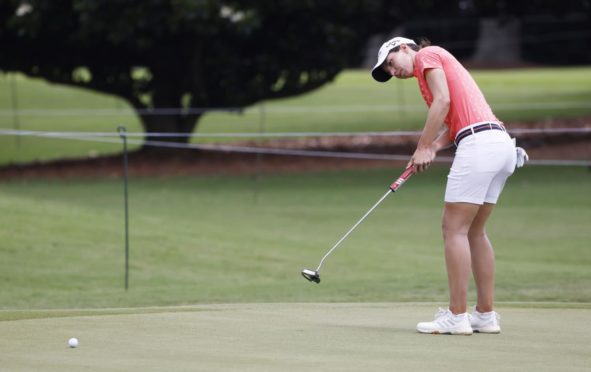For once in this weekly gripe-on-paper, let’s give some credit where it is due.
Although it’s still pretty much in baby steps, and I’m not entirely sure it’s being applied equitably, the world of golf is finally stumping up and doing something about slow play.
Regular readers – thank you again for your extreme forbearance – will know this is a T2G staple. Slow players have crawled their way around the top end of the game with complete impunity for far too long. There’s been a few brave enough to give voice to the frustration felt by so many – and every time they get support from just about everyone.
The first penalty in…eight years? Seriously?
But very little continues to be done. Only now, there are now slight stirrings.
At the PGA Championship last month, American John Catlin was penalised two shots for slow play in the second round.
This was the first time that a stroke penalty had been invoked at a men’s major championship since the 2013 Open at Muirfield. The culprit then was a young Hideki Matsuyama, who would go on to far better things.
Yes, eight years, with the same rules, and so many instances I can think of off the top of my head – not all involving JB Holmes – yet not a single sanction. But going against my usual form and seeing the glass half-full, hey, at least it was something.
A developing trend?
Maria Fassi's slow-play penalty dropped her outside the projected cut line at the @KPMGWomensPGA. https://t.co/r6DRy29rXz
— GOLF.com (@GOLF_com) June 25, 2021
And we may even have a trend developing. At the KPMG Women’s PGA Championship at the weekend, Mexico’s Maria Fassi was pinged for being over the 30 second limit whilst her group was on the clock, and incurred a two-shot penalty.
Fassi, somewhat predictably, didn’t think she was the problem. The group were being timed because of one of her playing partners, she insisted. That’s entirely possible, but to go over time when you knew fine well the group were on the clock was a little careless, at best.
The LPGA have been on the march slow-play wise this season. Carlota Ciganda, the Solheim Cup star, lost a group match in the Bank of Hope LPGA Matchplay event due to a slow play penalty.
Earlier in the year Yealimi Noh received a $10,000 fine for slow play at the Kia Classic. That was a bigger sum than usual because she’d had previous form. It also disproved the usual complaint that fines don’t hurt mega-rich players – it was more than double her prizemoney from the event.
Was The Renaissance a tipping point?
I’d like to think the women reached a tipping point with this at last year’s Scottish Open at The Renaissance. Then, Stacy Lewis won the title in spite of the incredibly slow play inflicted on her in the two final rounds by playing partners Jennifer Song and Azahara Munoz.
I wrote a T2G column at the time about this almost despairing how endemic slow play had become across the game.
Lewis, even having won, still spoke out publicly about the issue not improving in the women’s game since the glacial Solheim Cup a year before. The obvious frustrations and distractions for her playing with two such slow players made her victory downright heroic. It was also an eloquent statement about the actual efficacy of playing slowly.
Lewis spoke about that week on a recent interview with the always-excellent No Laying Up podcast. Interestingly, she also offered a real glimmer of hope.
She recalled how a week or two later Munoz approached her again – not to respond negatively to her comments but to ask for tips on how to play quicker. The Spaniard said she had real issues with decision-making and wanted to change.
And that’s where one has to be optimistic. It showed a real self-awareness on Munoz’s part to admit she had a problem. It also underlined the vast majority of the people – fans, officials and yes, players – hate slow play and want it challenged.
Even some of those doing it. Bryson DeChambeau, a serial offender in so many ways in recent times, has improved his pace fairly considerably. And he freely admitted it had been an issue, as well.
Why are we still so reticent about dealing with this?
It makes one wonder why is there still such an obvious reticence within officialdom for acting on slow play?
Even the instance of Catlin at the PGA was slightly puzzling. The three-time European Tour winner was bang-to-rights on the second day, a bad time whilst on the clock. Under the rules, there should be no alternative.
But we all know there is an alternative to names more recognisable than Catlin’s. There’s an indulgence applied to the top names, especially leading PGA Tour players. Catlin, not a PGA Tour member, playing on an invite and not that well known to his native audience, was something of a soft target.
But, these are baby steps. We’ve established that it’s possible to dock strokes in a major, that it’s possible to dock strokes which affect results. Ciganda was all-square playing the last and thought she’d won, only for the penalty to mean she’d lost.
We’ve established the established rules can be applied – Fassi may not have been the reason her group was on the clock, but she definitely breached the rules.
Now is the time to make a statement
Now the authorities need to take on a prominent name who well all know is serially guilty. And in a prominent, meaningful event. As Brooks Koepka is fond of saying, it’s right there in the rule book. Why isn’t it applied the way the other rules are?
At the moment some are so entitled, they think they’re bullet-proof. They think it only happens to the John Catlin and Maria Fassis of this world.
It’s way past time to prove them wrong, and send a clear message that slow play is unacceptable by anyone.


